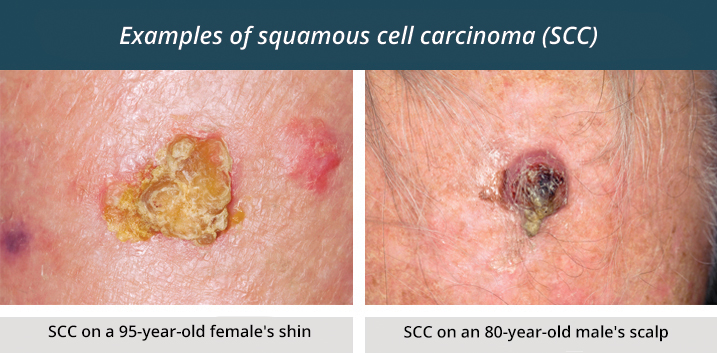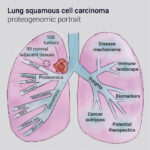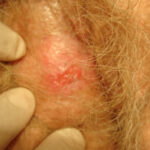Squamous cell carcinoma (SCC) of the skin is a common type of non-melanoma skin cancer, originating from the squamous cells that make up the outermost layer of the skin. While it is more common in individuals with fair skin and those exposed to excessive sun, SCC can affect anyone. This article delves into the causes, symptoms, risk factors, diagnosis, treatment options, and prevention strategies for squamous cell carcinoma of the skin.

What Is Squamous Cell Carcinoma of the Skin?
Squamous cell carcinoma (SCC) is a malignant tumor that arises from the squamous cells, which are flat cells located in the epidermis. It is one of the two most common types of skin cancer, the other being basal cell carcinoma (BCC). SCC typically occurs on sun-exposed areas of the body, such as the face, ears, neck, scalp, chest, backs of hands, arms, or lips. In rare cases, SCC can develop in mucous membranes like the mouth or genitals.
Major Risk Factors for Squamous Cell Carcinoma of the Skin
Ultraviolet (UV) Radiation Exposure
The primary cause of SCC is prolonged exposure to ultraviolet (UV) radiation from the sun or tanning beds. UV radiation damages the DNA in skin cells, leading to mutations that can cause the cells to become cancerous.
Fair Skin and Sun Sensitivity
Individuals with fair skin, light hair, and blue or green eyes are more likely to develop SCC. Those who sunburn easily and have a history of excessive sun exposure or sunburns are also at higher risk.
Age and Gender
SCC becomes more common with age, as prolonged UV exposure over the years accumulates. Men are also more likely than women to develop SCC, especially in sun-exposed areas.
Weakened Immune System
Immunosuppressed individuals, such as organ transplant recipients or those with HIV, are at increased risk for SCC due to a decreased ability to repair DNA damage and fight off abnormal cell growth.
Chronic Skin Conditions
Conditions such as actinic keratosis (precancerous lesions), human papillomavirus (HPV) infections, and other skin disorders may increase the risk of SCC.
Chemical Exposure
Long-term exposure to certain chemicals, such as arsenic, can increase the risk of developing SCC.
Clinical Symptoms of Squamous Cell Carcinoma of the Skin
The symptoms of SCC can vary depending on the size, location, and stage of the tumor. Common signs and symptoms include:
- A firm, red nodule: Often with a crusted or scaly surface
- Flat, scaly lesions: With a crusted or ulcerated center
- Bleeding or oozing from a lesion: Especially if it’s left untreated
- Sores that do not heal: Or reappear after healing
- Pain or tenderness: In or around the lesion, especially if it grows
- Itching: Sometimes associated with the tumor
Diagnostic Approach for Squamous Cell Carcinoma of the Skin
Physical Examination
A thorough physical examination by a healthcare provider can identify suspicious skin lesions. The provider will assess the lesion’s size, shape, color, and texture.
Skin Biopsy
To confirm a diagnosis of SCC, a biopsy is typically performed. The most common types of skin biopsies include:
- Shave biopsy: A thin layer of skin is shaved off.
- Punch biopsy: A small, circular piece of skin is removed for analysis.
- Excisional biopsy: The entire lesion is excised, including a small margin of surrounding skin.
Imaging Tests
In cases where SCC is suspected to have spread beyond the skin, imaging studies such as a CT scan, MRI, or lymph node ultrasound may be performed to evaluate whether the cancer has metastasized to other areas, including the lymph nodes.
Staging of Squamous Cell Carcinoma
The staging of SCC is essential for determining treatment options and prognosis. The AJCC TNM staging system is used to classify SCC based on the following components:
- T (Tumor): Describes the size and extent of the primary tumor.
- N (Nodes): Indicates whether cancer has spread to regional lymph nodes.
- M (Metastasis): Refers to whether cancer has spread to distant areas of the body.
Staging helps guide the management of SCC, from localized treatments to systemic therapies for more advanced cases.
Treatment Options for Squamous Cell Carcinoma of the Skin
Surgical Excision
Surgical excision remains the most common and effective treatment for localized SCC. The procedure involves removing the tumor along with a margin of healthy tissue. The goal is to ensure that no cancerous cells are left behind.
Mohs Micrographic Surgery
Mohs surgery is a specialized technique used for treating SCC in areas where preserving healthy tissue is important, such as the face, ears, and hands. The surgeon removes the tumor layer by layer, examining each layer under a microscope until no cancerous cells remain.
Radiation Therapy
For SCC that cannot be surgically removed or has spread, radiation therapy may be used. It is particularly effective for tumors located in areas difficult to treat surgically, such as near the eyes or nose.
Topical Treatments
In early-stage SCC or in cases where surgery is not an option, topical treatments such as 5-fluorouracil (5-FU) or imiquimod may be used to destroy cancer cells on the skin surface.
Cryotherapy
Cryotherapy involves freezing the tumor with liquid nitrogen to destroy abnormal cells. This treatment is often used for superficial SCC or pre-cancerous lesions.
Chemotherapy
Chemotherapy is typically reserved for advanced SCC that has spread to other parts of the body. It may be used in combination with other treatments to control the spread of the cancer.
Prognosis and Survival Rates for Squamous Cell Carcinoma of the Skin
The prognosis for squamous cell carcinoma of the skin is generally excellent when detected early and treated appropriately. The 5-year survival rate for localized SCC is approximately 95%. However, the survival rate decreases if the cancer has spread to the lymph nodes or distant organs.
Factors that influence prognosis include the size and location of the tumor, whether it has spread, and the patient’s overall health.
Prevention and Risk Reduction
Sun Protection
The most effective way to prevent SCC is to minimize UV radiation exposure. This includes:
- Using broad-spectrum sunscreen with SPF 30 or higher
- Wearing protective clothing such as hats and long sleeves
- Avoiding tanning beds
- Seeking shade during peak sun hours
Regular Skin Checks
Regular self-examinations and professional skin exams can help detect early signs of SCC. Early detection significantly improves the outcome and reduces the need for extensive treatments.
Avoiding Known Carcinogens
Minimizing exposure to chemicals such as arsenic and certain industrial solvents can reduce the risk of SCC.
Frequently Asked Questions:
How can I tell if I have squamous cell carcinoma?
Look for new growths, persistent sores, or changes in existing moles. Seek medical attention for any suspicious lesion that bleeds, crusts, or doesn’t heal.
Is squamous cell carcinoma of the skin curable?
Yes, SCC is highly treatable and often curable when detected early and treated promptly.
Can squamous cell carcinoma spread?
Yes, if left untreated, SCC can spread to nearby lymph nodes and distant organs. Early treatment is essential to prevent metastasis.
What are the chances of SCC recurring?
Recurrence is possible, particularly for larger tumors or those located on high-risk areas. Regular follow-up exams are necessary to monitor for recurrence.
Is squamous cell carcinoma only caused by sun exposure?
While UV radiation is the primary cause, other factors like exposure to certain chemicals or a weakened immune system can also increase the risk of SCC.
Squamous cell carcinoma of the skin is a common but treatable form of skin cancer, with a high cure rate when caught early. Prevention through sun protection and regular skin checks is key to reducing the risk of SCC. With various treatment options available, including surgery, radiation, and topical therapies, individuals diagnosed with SCC can expect favorable outcomes, especially with early intervention.

